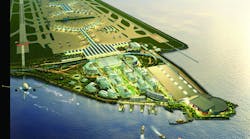At the recent Airport Cities Conference held in Denver, ACI World director general Angela Gittens relates that airports must be allowed to expand their role as infrastructure providers to a role that allows them to be operated as businesses in their own right.
This really is the essence and foundation of the airport city and aerotropolis concept. Coined by Dr. John Kasarda, director of the Kenan Insititue of Private Enterprise, the aerotropolis concept recognizes that airports are large players in the role of economic development for cities and regions.
Our May cover story on airport terminal facility design speaks to the primary aspect that underpins the aerotropolis concept: planning, and more importantly, planning together.
The 21st century demands transit-oriented development, incorporating stratagies that include building sustainably; harnessing technology to optimize the travel experience and better serve the airport user; facilitation of multi-modal development and initiatives; and area-wide stakeholder participation and engagement.
The global economy is an aviation-based economy, says Kosarda. "Airports have become major commercial magnates and regional economic accelerators," he comments. The airport city is made possible by "Airports doing business the way business does business," as Kosarda puts it.
Maintaining the focus on globalization, the airline industry has been affected by an increasingly globalized economy perhaps more than any other. In a presentation at the annual AAAE conference held in Phoenix in May, US Airways president Scott Kirby drove home that point, stating that the Delta and United mergers have created two behemoths that can outcompete due to their global comprehensive networks and ability to support large corporate accounts.
“The merger is good for the consumer because it brings a third player onto the playing field, particularly for those corporate accounts that have global travel needs, or for those elite business customers,” remarks Kirby.
What's that mean for airports? Well, according to Kirby, the deal is good for small city service.
He adds that there are some 31 cities on the east coast that US Airways serves and American does not; some of those would get service to places like Dallas and Chicago. Similarly, there are some 56 cities in the Midwest that American serves and US Airways doesn’t.
Overall, Kirby says bankruptcies have forced airlines to restructure, and the industry is on the threshold of completing the vision that it would consolidate into three large network carriers, and that they would be part of three global alliances.
Hmmm, looks like that's the way we are headed, for now at least. With so many factors involved - from the price of oil to the state of global terrorism - attempting to predict how the airline business will evolve can be a trying endeavor.
Alas, airports are the support system for the industry, and Airport Business is here to support you. We have positioned our portal website, AviationPros.com, to be the industry leader in global aviation industry news, information, and analysis. Please, feel free to contact me if you have suggestions for how we can better serve you.
Thanks for your interest,
BM



